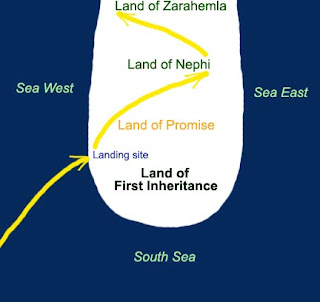 Bruce W. Warren and Thomas S. Ferguson, in their book “The Messiah in Ancient America,” in their inside cover map of the Land of Promise, defy all logic and reason by placing an East Sea to the North, and a West Sea to the South of the Land of Promise. This is the same tactic that other Mesoamerican Theorists use—a total disregard for the direction used in the Book of Mormon scripture.
Bruce W. Warren and Thomas S. Ferguson, in their book “The Messiah in Ancient America,” in their inside cover map of the Land of Promise, defy all logic and reason by placing an East Sea to the North, and a West Sea to the South of the Land of Promise. This is the same tactic that other Mesoamerican Theorists use—a total disregard for the direction used in the Book of Mormon scripture.Some, like Sorenson (Map 5, pg 37), use pages to defy this logic in explaining that not only did all the Nephites not know their cardinal directions, but that their earlier knowledge of directions in Jerusalem was based on how they stood in relation to the sea.
There are two Seas recorded in the Book of Mormon record that correlate to known bodies of water which can not only be identified, but also interpreted for comparison with the use of the word “sea” later in the record.
After traveling eastward through the barren desert of Arabia, the Lehi Colony came upon a coastal area they “called Bountiful, because of its much fruit and also wild honey” (1 Nephi 17:5). From this isolated oasis along the coast Nephi says they “beheld the sea, which we called Irreantum, which, being interpreted, is many waters” (1 Nephi 17:5).
Nephi connects the definition of “sea” with the word “Irreantum” and the phrase “many waters,” showing that all three have the same basic meaning—that is a salt sea. Thus Nephi’s record appears to define “many waters” as a large body of salt water. This is also found in the earlier comment about traveling in a south-southeast direction (1 Nephi 16:13) along the Red Sea (1 Nephi 16:14)—also a salt sea.
 When the Nephites crossed the Irreantum Sea and arrived in the Land of Promise, they landed toward the south along the coast of what they called the West Sea (Alma 22:28). This land was referred to as the land of First Inheritance (Mosiah 9:1;10:13;Alma 22:28). In the following verses, Mormon inserts a description of the land so the future reader can visualize the Land of Promise—at least the land to the south which was “nearly surrounded by water” except for a “small neck of land between the Land Northward and the Land Southward” (Alma 22:32). Thus, the Land Southward, containing the Land of Nephi and the Land of Zarahemla, and Bountiful on the north, just south of this narrow neck, were completely surrounded by water except for the narrow neck of land (Alma 22:22:32), which had the east sea on one side and the west sea on the other side (Alma 50:34). This narrow neck of land kept the sea from completely dividing the land (Ether 10:20).
When the Nephites crossed the Irreantum Sea and arrived in the Land of Promise, they landed toward the south along the coast of what they called the West Sea (Alma 22:28). This land was referred to as the land of First Inheritance (Mosiah 9:1;10:13;Alma 22:28). In the following verses, Mormon inserts a description of the land so the future reader can visualize the Land of Promise—at least the land to the south which was “nearly surrounded by water” except for a “small neck of land between the Land Northward and the Land Southward” (Alma 22:32). Thus, the Land Southward, containing the Land of Nephi and the Land of Zarahemla, and Bountiful on the north, just south of this narrow neck, were completely surrounded by water except for the narrow neck of land (Alma 22:22:32), which had the east sea on one side and the west sea on the other side (Alma 50:34). This narrow neck of land kept the sea from completely dividing the land (Ether 10:20).Thus, to the east of the Land of Zarahemla and the Land of Nephi was the East Sea (Alma 22:27; 50:8) and to the west was the West Sea (Alma 22:28). And, obviously there was a South Sea (Helaman 3:8), which led Jacob to write “for the Lord has made the sea our path, and we are upon an isle of the sea” (2 Nephi 10:20-21).
The only time in the Book of Mormon where a direction is used that can be exactly verified, they are correct. (1 Nephi 16:13;17:1), so why does Sorenson claim the Nephites did not know directions? Because his Mesoamerican model is 90º off kilter to the cardinal directions and does not fit the use of north, south, east or west used in the scriptures. One might call that being disingenuous.




No comments:
Post a Comment